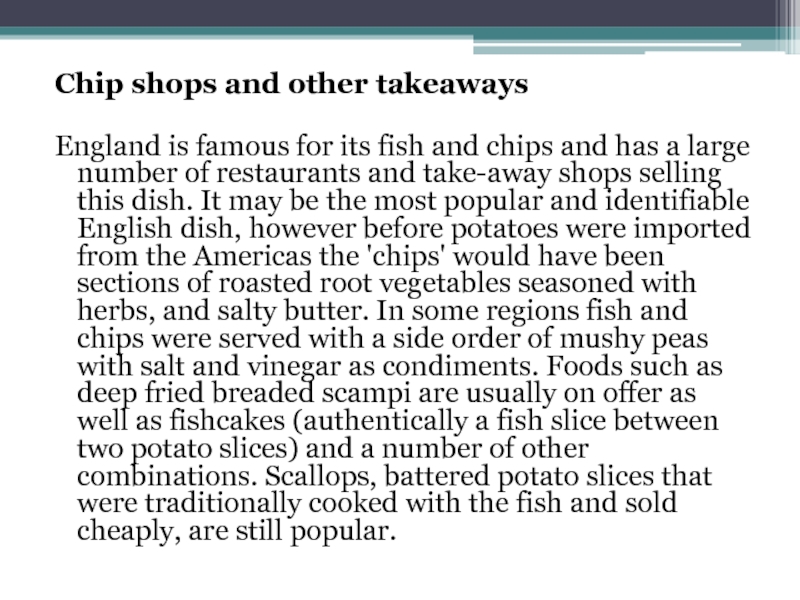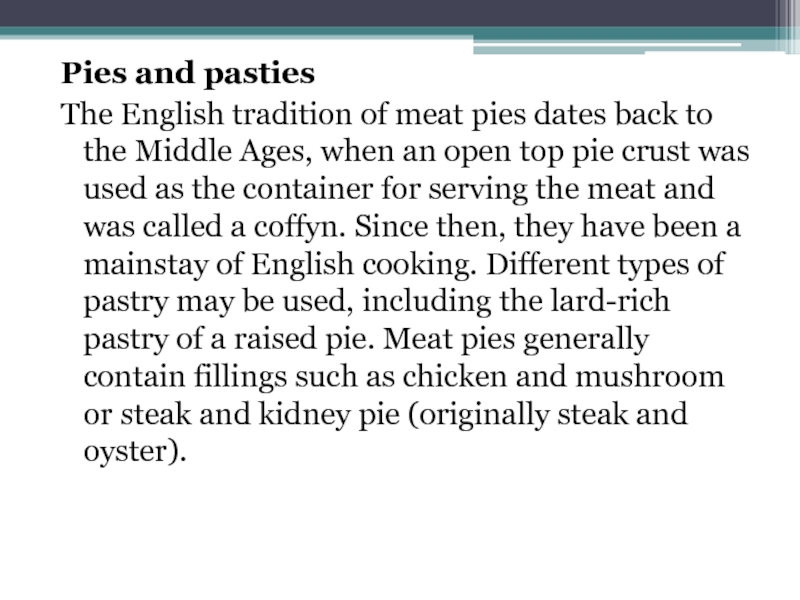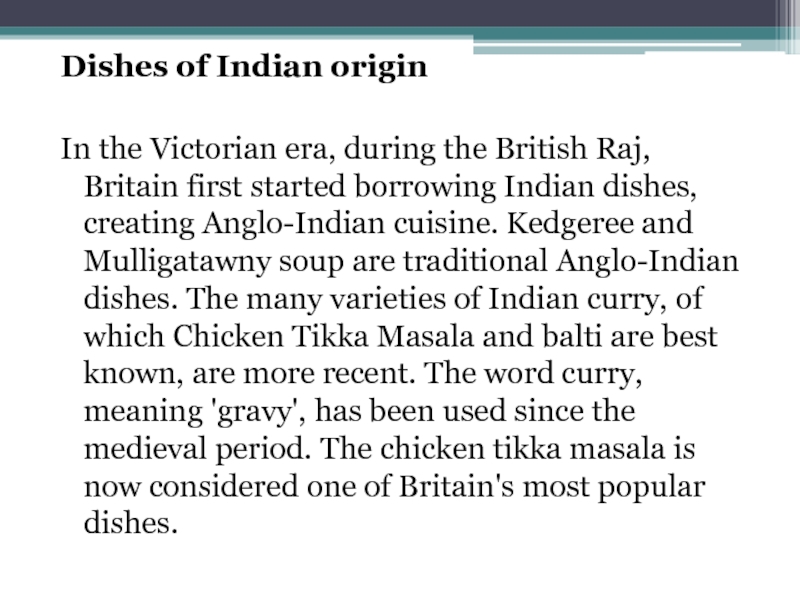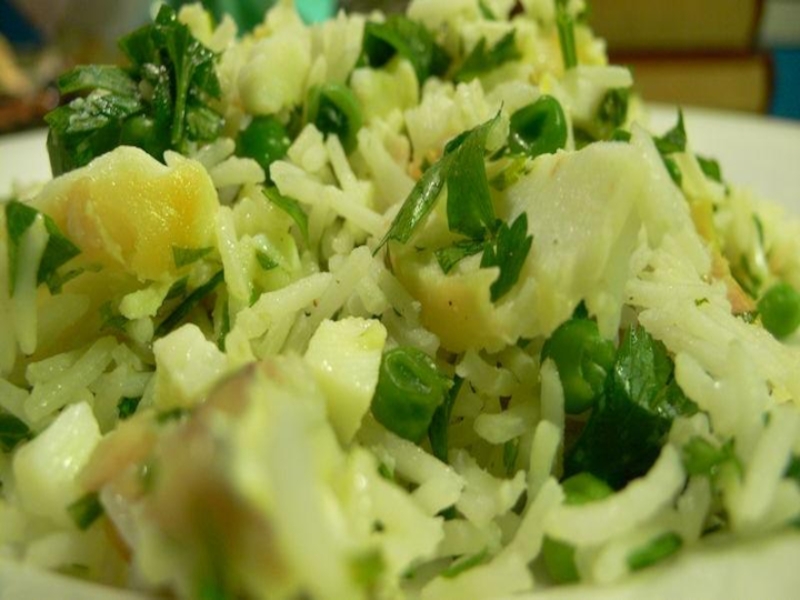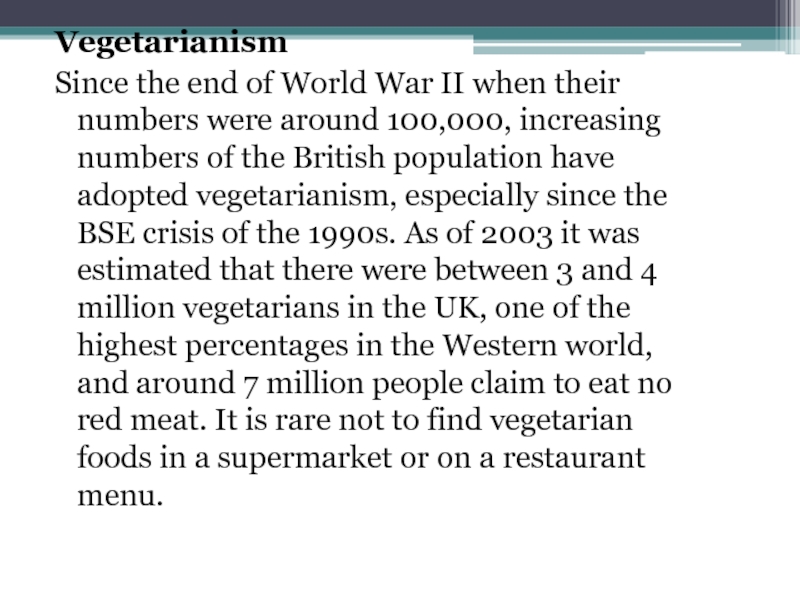Разделы презентаций
- Разное
- Английский язык
- Астрономия
- Алгебра
- Биология
- География
- Геометрия
- Детские презентации
- Информатика
- История
- Литература
- Математика
- Медицина
- Менеджмент
- Музыка
- МХК
- Немецкий язык
- ОБЖ
- Обществознание
- Окружающий мир
- Педагогика
- Русский язык
- Технология
- Физика
- Философия
- Химия
- Шаблоны, картинки для презентаций
- Экология
- Экономика
- Юриспруденция
English cuisine
Содержание
- 1. English cuisine
- 2. English cuisine encompasses the cooking styles, traditions
- 3. The Sunday roast was once the
- 4. Слайд 4
- 5. Afternoon teaIt is a widespread stereotype that
- 6. Chip shops and other takeawaysEngland is famous
- 7. Слайд 7
- 8. SausagesEnglish sausages, colloquially known in certain regions
- 9. Слайд 9
- 10. Pies and pastiesThe English tradition of meat
- 11. Dishes of Indian originIn the Victorian era,
- 12. Слайд 12
- 13. International and fusion cuisineIndian cuisine is the
- 14. Anglo Indian Fusion food started during the
- 15. Слайд 15
- 16. VegetarianismSince the end of World War II
- 17. “The contemporary English cuisine has incorporated many new ingredients, retaining the traditional flavor and the richness.”
- 18. Скачать презентанцию
English cuisine encompasses the cooking styles, traditions and recipes associated with England. It has distinctive attributes of its own, but also shares much with wider British cuisine, largely due to the
Слайды и текст этой презентации
Слайд 3The Sunday roast
was once the most common
feature of English cooking. The Sunday dinner traditionally includes roast
potatoes (or boiled or mashed potatoes) accompanying a roasted joint of meat such as roast beef, lamb, pork, or a roast chicken and assorted other vegetables, themselves generally boiled and served with a gravy. Sauces are chosen depending on the type of meat: horseradish for beef, mint sauce for lamb, apple sauce for pork, and bread sauce for chicken. Yorkshire pudding normally accompanies beef (although it was originally served first as a "filler"), sage and onion stuffing pork, and usually parsley stuffing chicken; gravy is now often served as an accompaniment to the main course.Слайд 5Afternoon tea
It is a widespread stereotype that the English "drop
everything" for a teatime meal in the mid-afternoon. A formal
teatime meal is now often an accompaniment to tourism, particularly in Devon and neighbouring counties, where comestibles may include scones with jam and clotted cream (together known as a cream tea). There are also butterfly cakes, simple small sponge cakes which can be iced or eaten plain. Nationwide, assorted biscuits and sandwiches are eaten. Generally, however, the teatime meal has been replaced by snacking, or simply dispensed with.Слайд 6Chip shops and other takeaways
England is famous for its fish
and chips and has a large number of restaurants and
take-away shops selling this dish. It may be the most popular and identifiable English dish, however before potatoes were imported from the Americas the 'chips' would have been sections of roasted root vegetables seasoned with herbs, and salty butter. In some regions fish and chips were served with a side order of mushy peas with salt and vinegar as condiments. Foods such as deep fried breaded scampi are usually on offer as well as fishcakes (authentically a fish slice between two potato slices) and a number of other combinations. Scallops, battered potato slices that were traditionally cooked with the fish and sold cheaply, are still popular.Слайд 8Sausages
English sausages, colloquially known in certain regions as "bangers," are
distinctive in that they are usually made from fresh meats
and rarely smoked, dried, or strongly flavoured. Following the post World War II period, sausages tended to contain low-quality meat, fat, and rusk. (Reputedly the term "banger" derived from the excessive water added to the mix turning to steam while cooking and bursting the casing with a bang.)Pork and beef are by far the most common bases, although gourmet varieties may contain venison, wild boar. There are particularly famous regional varieties, such as the herbal Lincolnshire, and the long, curled Cumberland with many butchers offering their own individual recipes and variations often handed down through generations, but are generally not made from cured meats such as Italian selections or available in such a variety as found in Germany.
Слайд 10Pies and pasties
The English tradition of meat pies dates back
to the Middle Ages, when an open top pie crust
was used as the container for serving the meat and was called a coffyn. Since then, they have been a mainstay of English cooking. Different types of pastry may be used, including the lard-rich pastry of a raised pie. Meat pies generally contain fillings such as chicken and mushroom or steak and kidney pie (originally steak and oyster).Слайд 11Dishes of Indian origin
In the Victorian era, during the British
Raj, Britain first started borrowing Indian dishes, creating Anglo-Indian cuisine.
Kedgeree and Mulligatawny soup are traditional Anglo-Indian dishes. The many varieties of Indian curry, of which Chicken Tikka Masala and balti are best known, are more recent. The word curry, meaning 'gravy', has been used since the medieval period. The chicken tikka masala is now considered one of Britain's most popular dishes.Слайд 13International and fusion cuisine
Indian cuisine is the most popular alternative
to traditional cooking in Britain, followed by Chinese and Italian
cuisine food. Thai, Spanish, Jewish, Greek, Tex-Mex and Caribbean restaurants can also be found, with American and Middle Eastern food mostly represented in the take-away sector. Whereas most international food is pitched in the middle of the price range, French food tends to be considered haute cuisine.Indian restaurants typically allow the diner to combine a number of base ingredients– chicken, prawns or "meat" (lamb or mutton)– with a number of curry sauces, without regard to the authenticity of the combination. (Many restaurants are run by Muslims from the Indian sub-continent, so pork is rarely offered.) Meals are almost always accompanied by rice, usually basmati, with bread sometimes ordered in addition.
Слайд 14Anglo Indian Fusion food started during the British Raj with
such dishes as mulligatawny soup, kedgeree and coronation chicken. The
process continued with chicken tikka masala in the 1960s and Balti in the 1980s, although some claim the latter has roots in the subcontinent.Chinese food is predominantly derived from Cantonese cuisine, and so adapted to Western tastes that Chinese customers may be offered an entirely separate menu. Spare ribs in OK sauce is an example of crossover cuisine.
Caribbean and Jewish food are mostly eaten within their respective communities, although bagels are becoming more widespread as a snack
Слайд 16Vegetarianism
Since the end of World War II when their numbers
were around 100,000, increasing numbers of the British population have
adopted vegetarianism, especially since the BSE crisis of the 1990s. As of 2003 it was estimated that there were between 3 and 4 million vegetarians in the UK, one of the highest percentages in the Western world, and around 7 million people claim to eat no red meat. It is rare not to find vegetarian foods in a supermarket or on a restaurant menu.Слайд 17
“The contemporary English cuisine has incorporated many new ingredients, retaining
the traditional flavor and the richness.”
Теги





